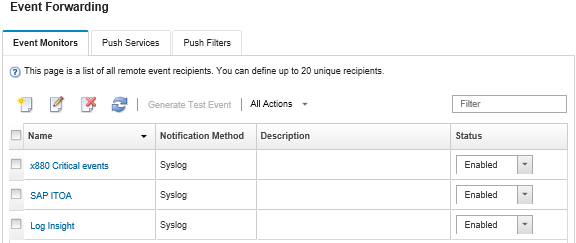Setting up event forwarding to a remote SNMPv1 or SNMPv3 manager
You can configure Lenovo XClarity Administrator to forward specific events to a remote SNMPv1 or SNMPv3 manager.
About this task
You can create and enable up to 20 event forwarders to send events to specific recipients.
If XClarity Administrator is rebooted after event forwarders are configured, you must wait for the management server to regenerate internal data before events are forwarded correctly.
For information about the XClarity Administrator MIB, see lenovoMgrAlert.mib file.
Procedure
Complete the following steps to create an event forwarder for a remote SNMPv1 or SNMPv3 manager.
After you finish
Refresh the list of event forwarders by clicking the Refresh icon (
 ).
).View details about a specific event forwarder by clicking the link in the Name column.
Change the event-forwarder properties and filter criteria by clicking the event-forwarder name in the Name column.
Delete the event forwarder by clicking the Delete icon (
 ).
).Suspend event forwarding (see Suspending event forwarding).
Download the MIB file that contains information about SNMP traps by clicking the Create icon (
 ), and then clicking Download MIB File on the General tab of New Event Forwarding dialog
), and then clicking Download MIB File on the General tab of New Event Forwarding dialog
